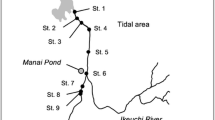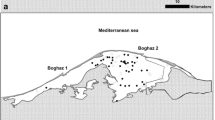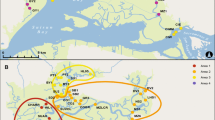Abstract
Among ricefishes of the genus Oryzias, the Javanese medaka (O. javanicus) and the Indian medaka (O. dancena) are highly adaptable to seawater. Although wide distribution of the two species in the brackish waters of South and South-East Asia has been reported, their habitat preference remains unknown. We surveyed 12 sites in five estuarial areas of the west coast of Peninsular Malaysia from Kuala Gula to Tanjung Piai. Both species were found in all five areas, suggesting their distribution throughout the west coast of Peninsular Malaysia. This is the southernmost-recorded appearance of O. dancena, to the best of our knowledge. However, the habitats of the two species were essentially separated: of the 12 surveyed sites, the species were found in co-existence at only two sites, and one or the other species was found alone at the remaining 10 sites. We compared temperature, salinity, pH, and dissolved oxygen (DO) at the sampling sites and found that the habitat of O. javanicus is with higher salinity and DO. The salinity and DO at the sites of co-existence are near the lowest values found at the O. javanicus-only sites, and the highest values at the O. dancena-only sites. These results suggest that O. javanicus and O. dancena habitats are essentially separated; the former prefers hyperosmotic conditions while the latter prefers hypoosmotic conditions, and the latter may be more tolerant of hypoxia. The two sites of co-existence are points of contact between the species’ separate distribution areas.

Similar content being viewed by others
References
Chen XP, Li L, Wong CKC, Cheng SH (2009) Rapid adaptation of molecular resources from zebrafish and medaka to develop an estuarine/marine model. Comp Biochem Physiol C 149:647–655
Imai S, Koyama J, Fujii K (2005) Effects of 17beta-estradiol on the reproduction of Java medaka (Oryzias javanicus), a new test fish species. Mar Polut Bull 51:708–714
Imai S, Koyama J, Fujii K (2007) Effects of estrone on full life cycle of Java medaka (Oryzias javanicus), a new marine test fish. Environ Toxicol Chem 26:726–731
Inoue K, Takei Y (2002) Diverse adaptability in Oryzias species to high environmental salinity. Zool Sci 19:727–734
Inoue K, Takei Y (2003) Asian medaka fishes offer new models for studying mechanisms of seawater adaptation. Comp Biochem and Physiol B 136:635–645
Iwamatsu T, Imaki A, Kawamoto A (1982) On Oryzias javanicus collected at Jakarta and West Kalimantan, Indonesia and Singapore. Annot Zoo of Japan 55:190–198
Kang CK, Tsai SC, Lee TH, Hwang PP (2008) Differential expression of branchial Na+/K(+)-ATPase of two medaka species, Oryzias latipes and Oryzias dancena, with different salinity tolerances acclimated to fresh water, brackish water and seawater. Comp Biochem Physiol A 151:566–575
Kang CK, Tsai HJ, Liu CC, Lee TH, Hwang PP (2010) Salinity-dependent expression of a Na+, K+, 2Cl(−) cotransporter in gills of the brackish medaka Oryzias dancena: A molecular correlate for hyposmoregulatory endurance. Comp Physiol Biochem A 157:7–18
Kinoshita M, Murata K, Naruse K, Tanaka M (2009) Medaka: biology, management, and experimental protocols. Iowa, Wiley-Blackwell, p 444
Koyama J, Kawamata M, Imai S, Fukunaga M, Uno S, Kakuno A (2008) Java medaka: A proposed new marine test fish for ecotoxicology. Env Toxicol 23:487–491
Magtoon W, Termvidchakorn A (2009) A revised taxonomic account of rice fish Oryzias (Beloniformes; Adrianichthyidae), in Thailand, Indonesia and Japan. The Natural History Journal of Chulalongkorn University. 9:35–68
Parenti LR (2008) A phylogenetic analysis and taxonomic revision of rice fishes, Oryzias and relatives (Beloniformes, Adrianichthyidae). Zool J of the Linnaean Soc 154:494–610
Okino T, Uwa H (1994) Phylogeny and species differentiation of Adrianichthyoides in Indonesia. In: Okino T (ed) Phylogeny and species differentiation of Adrianichthyoidei in Indonesia. Report of Monbusho International Scientific Research Program, No. 04041052, pp 7–13
Roberts TR (1998) Systematic observations on tropical Asian medakas or rice fishes of the genus Oryzias with descriptions of four new species. Ichthyol Res 45:213–224
Shen M, Xu JL, Tsang TY, Au DWT (2010) Toxicity comparison between Chattonella marina and Karenia brevis using marine medaka (Oryzias melastigma): Evidence against the suspected ichthyotoxins of Chattonella marina. Chemosphere 80:585–591
Takehana Y, Naruse K, Sakaizumi M (2005) Molecular phylogeny of the medaka fishes genus Oryzias (Beloniformes: Adrianichthyidae) based on molecular and mitochondrial DNA sequences. Mol Phylogenet and Evol 36:417–428
Takehana Y, Nagai N, Matsuda M, Tsuchiya K, Sakaizumi M (2003) Geographic variation and diversity of the cytochrome b gene in Japanese wild populations of Medaka, Oryzias latipes. Zool Sci 20:1279–1291
Takehana Y, Uchiyama S, Matsuda M, Jeon SR, Sakaizumi M (2004) Geographic variation and diversity of the cytochrome b gene in wild populations of medaka (Oryzias latipes) from Korea and China. Zool Sci 21:483–491
Takei Y, Inoue K, Trajanovska S, Donald JA (2011) B-type natriuretic peptide (BNP), not ANP, is the principal cardiac natriuretic peptide in vertebrates as revealed by comparative studies. Gen Comp Endocrinol 171:258–266
Wittbrodt J, Shima A, Schartl M (2002) Medaka—A model organism from the Far East. Nat Rev Genet 3:53–64
Woo S, Won H, Jeon HY, Kim B, Lee TK, Park HS, Yum S (2009a) Heterologous microarray hybridization used for differential gene expression profiling in Benzo[a]pyrene-exposed Marine Medaka. Mol Cell Toxicol 5:283–290
Woo S, Yum S, Park HS, Lee TK, Ryu JC (2009b) Effects of heavy metals on antioxidants and stress-responsive gene expression in Javanese medaka (Oryzias javanicus). Comp Biochem Physiol C 149:289–299
Author information
Authors and Affiliations
Corresponding author
Rights and permissions
About this article
Cite this article
Yusof, S., Ismail, A., Koito, T. et al. Occurrence of two closely related ricefishes, Javanese medaka (Oryzias javanicus) and Indian medaka (O. dancena) at sites with different salinity in Peninsular Malaysia. Environ Biol Fish 93, 43–49 (2012). https://doi.org/10.1007/s10641-011-9888-x
Received:
Accepted:
Published:
Issue Date:
DOI: https://doi.org/10.1007/s10641-011-9888-x




